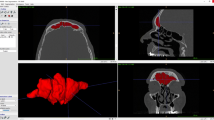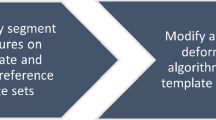Abstract
Purpose An initialization-free approach for perioperative registration in functional endoscopic sinus surgery (FESS) is sought. The quality of surgical navigation relies on registration accuracy of preoperative images to the patient. Although landmark-based registration is fast, it is prone to human operator errors. This study evaluates the accuracy of two well-known methods for segmentation of the occipital bone from CT-images for use in surgical 3D-navigation.
Method The occipital bone was segmented for registration without pre-defined correspondences, with the iterative closest point algorithm (ICP). The thresholding plus marching cubes segmentation (TMCS), and the deformable model segmentation (DMS) were compared quantitatively by overlaying the areas of the segmentations in cross-sectional slices, and visually by displaying the pointwise distances between the segmentations in a three-dimensional distance map relative to an expert manual segmentation, taken as a “ground truth”.
Results Excellent correspondence between the two methods was achieved; the results showed, however, that the TMCS is closer to the “ground truth”. This is due to the sub-voxel accuracy of the marching cubes algorithm by definition, and the sensitivity of the DMS method to the choice of parameters. The DMS approach, as a gradient-based method, is insensitive to the thresholding initialization. For noisy images and soft tissue delineation a gradient-based method, like the deformable model, performs better. Both methods correspond within minute differences less than 4%.
Conclusion These results will allow further minimization of human interaction in the planning phase for intraoperative 3D-navigation, by allowing to automatically create surface patches for registration purposes, ultimately allowing to build an initialization-free, fully automatic registration procedure for navigated Ear-, Nose-, Throat- (ENT) surgery.
Similar content being viewed by others
References
Wagner A, Schicho K, Birkfellner W, Figl M, Seemann R, Konig F, Kainberger F and Ewers R (2002). Quantitative analysis of factors affecting intraoperative precision and stability of optoelectronic and electromagnetic tracking systems. Med Phys 29(5): 905–912
Besl PJ and Mckay ND (1992). A Method for Registration of 3-D Shapes. IEEE Trans. Pattern Anal Mach Intell 14(2): 239–256
Sonka M, Fitzpatrick JM (2004) Handbook of medical imaging. SPIE. ISBN 0-8194-3622-4
Yoo TS (2004) Insight into images: principles for segmentation, Registration, and image analysis. AK Peters Ltd. ISBN 1-56881-217-5
Fritscher KD, Schubert R (2006) 3D image segmentation by using statistical deformation models and level sets. Int J CARS (1):123–135
Chen T and Metaxas D (2005). A hybrid framework for 3D medical image segmentation. Med Image Anal 9(6): 547–565
Ferrari RJ (2004). Identification of the breast boundary in mammograms using active contour models. Med Biol Eng Comput 42(2): 201–208
Cootes TF and Taylor CJ (1995). Active shape models—their training and Application. Comput Vision Image Understand 61(1): 38–59
Lorensen WE and Cline HE (1987). Marching cubes: a high resolution 3d surface construction algorithm. Computer Graphics 21(4): 163–169
Gunkel AR, Freysinger W and Thumfart WF (2000). Computer-aided 3D-navigation systems. Survey and location determination (in German). HNO 48: 75–90
Shu R and Zhou C (1995). Adaptive marching cubes. Visual Comput 11: 202–217
Lopes A and Brodlie K (2003). Improving the robustness and accuracy of the marching cubes algorithm for isosurfacing. IEEE Trans Visualizat Comput Graphics 9(1): 16–29
Ju T and Schaefer SD (2003). Convex contouring of volumetric data. Visual Comput 19(7–8): 513–525
Thirion J-P (1998) Segmentation and registration of multimodal medical images: From theory, implementation and validation to a useful tool in clinical practice. http://www.medicalimagecomputing.com/tools/downloads.php?fileID=179
McInerney T and Terzopoulus D (1996). Deformable models in medical image analysis: a survey. Med Image Anal 1(2): 91–108
Mykkanen J and Tohka J (2005). Automatic extraction of brain surface and mid-sagittal plane from PET images applying deformable models. Comput Methods Programs Biomed 79(1): 1–17
Putter S and Laffargue F (2006). Computational mesh generation for vascular structures with deformable surfaces. Int J CARS 1: 39–49
Udupa JK (2002) A methodology for evaluating image segmentation algorithms. Proc SPIE. http://bil.bme.columbia.edu
http://www.slicer.org
Ueberhuber C, Katzenbeisser S (2002) MatLab 6.5 Eine Einführung. Springer, Heidelberg. ISBN 3-211-83826-0
http://public.kitware.com/VTK
Ibanez L (2003) The ITK software guide. Kitware, Inc. ISBN 1-930934-10-6
Goldstein H (1981) Klassische Mechanik [Classical Mechanics]. Akademische Verlagsgesellschaft, ISBN 3-400-001-34-1
http://www.fltk.org
Rhodes PJ, Laramee RS (2003) Uncertainty visualization methods in isosurface rendering. Eurographics, Short Papers:83–88. http://citeseer.ist.psu.edu/rhodes03uncertainty.html
Madabhushi A and Metaxas D (2003). Combining low-, high-level and empirical domain knowledge for automated segmentation of ultrasonic breast lesions. IEEE Trans Med Imag 22(2): 155–169
Malthan D, Ehrlich G, Stallkamp J, Dammann F, Schwaderer E and Maassen MM (2003). Automated registration of partially defective surfaces by local landmark identification. Comput Aided Surg 8(6): 300–309
Lavallee S, Sautot P, Troccaz J, Cinquin P and Merloz P (1995). Computer-assisted spine surgery: a technique for accurate transpedicular screw fixation using CT data and a 3-D optical localizer. J Image Guid Surg 1(1): 65–73
Diakov GM, Freysinger W (2007) Intraoperative A-mode ultrasound for automatic registration in ENT 3D-navigation (a cadaver study). Poster presentation CARS, Berlin, Germany, 27–30 June 2007
Gao J, Shen HW (2003) Hardware-assisted view-dependent isosurface extraction using spherical partition. Joint EUROGRAPHICS—IEEE TCVG http://citeseer.ist.psu.edu/gao03hardwareassisted.html
Author information
Authors and Affiliations
Corresponding author
Rights and permissions
About this article
Cite this article
Diakov, G., Freysinger, W. Accuracy evaluation of initialization-free registration for intraoperative 3D-navigation. Int J CARS 2, 65–73 (2007). https://doi.org/10.1007/s11548-007-0119-z
Received:
Accepted:
Published:
Issue Date:
DOI: https://doi.org/10.1007/s11548-007-0119-z




